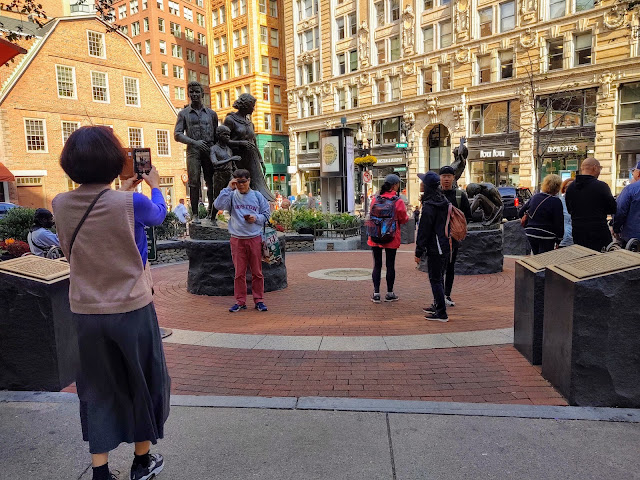On June 28, 1998, Boston's Irish Famine Memorial was Unveiled at Washington and School Streets
On June 28, 1998, the Boston Irish Famine Memorial was unveiled in downtown Boston, at the corner of Washington and School Street. The effort was led by Irish immigrant and businessman Thomas J. Flatley, whose committee included representatives from Boston's Irish community, artist community and from academia.
More than 7,000 people attended the ceremony on a Sunday morning, including Ireland's Minister of State Seamus Brennan, Massachusetts Acting Governor Paul Cellucci, Boston Mayor Tom Menino, and leaders for numerous Irish organizations in Massachusetts.
Stonehill College President Rev. Bartley MacPhaidin gave the invocation, and music was provided by the Boston Police Gaelic Column of Pipes and Drums.
The Memorial by artist Robert Shure juxtaposes an Irish family starving in Ireland with another Irish family striving for success in America. Eight narrative plaques encircling the statues tell the story of the famine and the Irish triumph in America.
A U.S. Medal of Honor Winner, a Holocaust survivor were among those who read from the eight plaques that encircled the memorial. A Vietnamese and Rwandan also read from the plaques, an acknowledgment of modern day refugees who continue to seek solace in Boston.
Read the text of the eight plaques here.
The $1 million memorial park commemorates the 150th anniversary of the Irish Famine (1845-49), during which one million people died of starvation or disease and nearly two million fled Ireland to avoid death. Over 100,000 Irish refugees arrived in Boston during this time, transforming the city.
Their arrival revealed deep-seeded hostility among some Bostonians, prompting an anti-immigrant nativist movement in the 1850s known as the Know Nothing Party. "No Irish Need Apply" signs were regularly posted in newspapers and in store windows. There were reports of Irish families sleeping in the bushes on Boston Common, or dying of typhus in basement apartments along Broad Street.
Unjust political reigns and economic instability in Ireland prompted a steady stream of Irish emigrants to Boston and other parts of North America. The tribulations of the Famine generation were ultimately vindicated by the success of Irish-Americans, culminating in the election of President John F. Kennedy in 1960, whose eight great grandparents all left Ireland during the Famine years to find a better life in Boston.
Located across from the historic Old South Meeting House, thousands of visitors from around the world, school groups, and local residents visit the Irish Famine Memorial each year. The memorial park is along the city's Freedom Trail and is part of Boston's Irish Heritage Trail, a self-guided walk covering 300+ years of Boston Irish history.






Comments